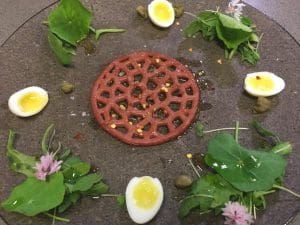THE writing could be on the plate for Australia’s first pop-up fully 3D-printed restaurant.
And lamb and beef will be on the menu if Meat & Livestock Australia has anything to do with it.
MLA supported the successful 3D Food Printing Conference Asia-Pacific at Monash University in Melbourne on May 2, which explored red meat opportunities for the technology.
MLA’s value chain innovation program manager Michael Lee said about 100 delegates from the red meat industry, research sector and food technology sector attended the conference.
“While results and feedback from the event is currently being collated, the conference generated significant interest within Australia and internationally, particularly around the potential opportunities for the red meat industry to utilise 3D printing technology.”
Mr Lee said there is “early interest” in a pop-up 3D-printed food restaurant company to come to Australia.
“This would include a lamb dish and all other consumables – even the plates, tables and cutlery all being 3D-printed,” he said.
MLA is in preliminary discussions with the company, which has not been named, but it is not Food Ink, which has already launched a 3D-printing restaurant in the United Kingdom.
Food Ink — an initiative that brought together architects, artists, chefs, designers, engineers, futurists, industrials, inventors and technologists — launched the world’s first 3D-printing restaurant in London last year, providing a “one-of-a-kind gourmet experience in which all the food, all the utensils and all the furniture are completely produced through 3D-printing in an immersive futuristic space”.
“We are a conceptual pop-up dinner series where fine cuisine meets art, philosophy and tomorrow’s technologies,” the http://foodink.io/#futuristic website says.
Meat ink can add value to secondary cuts
Mr Lee said for red meat 3D printing represents an exciting opportunity to add value to current secondary cuts, trims and by-products by developing “meat ink”.
“For example, in the aged care sector, 3D printing provides an opportunity for the red meat industry to offer high protein and nutritious meals that can be presented in various shapes and sizes, and more appetising than the traditional pureed food. “
“This is a sector that has not necessarily been open to traditional red meat products due to issues around chewing and swallowing whole cuts.”

3D-printed lamb tartare dish. Picture – Monash University.
Mr Lee said at the recent Melbourne conference, a finely minced boneless lamb shoulder was the sole ingredient for the “meat ink”, and MLA chef Sam Burke demonstrated an intricately shaped raw lamb tartare at the conference.
MLA makes 3D printers available for red meat projects
Mr Lee said the MLA Donor Company (MDC) is now actively seeking expressions of interest from industry to partner with in the 3D printed technology space.
“Identifying the right usage and occasions for 3D Printed meat, the target market and the business model innovation required to deliver will be key activities.”

MLA chef Sam Burke preparing a 3D-printed beef dish. Picture – Monash University
Mr Lee said MLA is seeing a number of innovations in response to the “designed for me” and “personalised nutrition” trend and would consider the benefits for 3D printed meat products, made with 100 percent meat and with softer texture and perhaps also with inclusion of vegetables, could be a great opportunity for kids snacks and also for aged care.
“We have also seen Michelin star chefs begin to use 3D printers for creating amazing deserts and confectionary – this also is an exciting area for chef inspired 3D-printed meat canapés and tapas.”
Mr Lee said MLA is currently co-ordinating a program with researchers and 3D printer suppliers where proof of concept 3D-printed meat products can be developed on a small scale.
“MLA has purchased a unit and has been testing recipes and shapes in readiness for the conference and through our MLA Donor Company we are keen to collaborate with interested parties to develop 3D-printed sheep meat products.”
MLA’s research, development and innovation general manager, Sean Starling, said MLA has two 3D food printers available for Australian customers to use for experimenting with red meat raw ingredients.
“If your company is interested in utilising one of our 3D printers to evaluate red meat market opportunities please reach out to Michael Lee ([email protected]), Chef Sam Burke ([email protected]) or myself to establish an evaluation project,” Mr Starling wrote in a LinkedIn post.

HAVE YOUR SAY